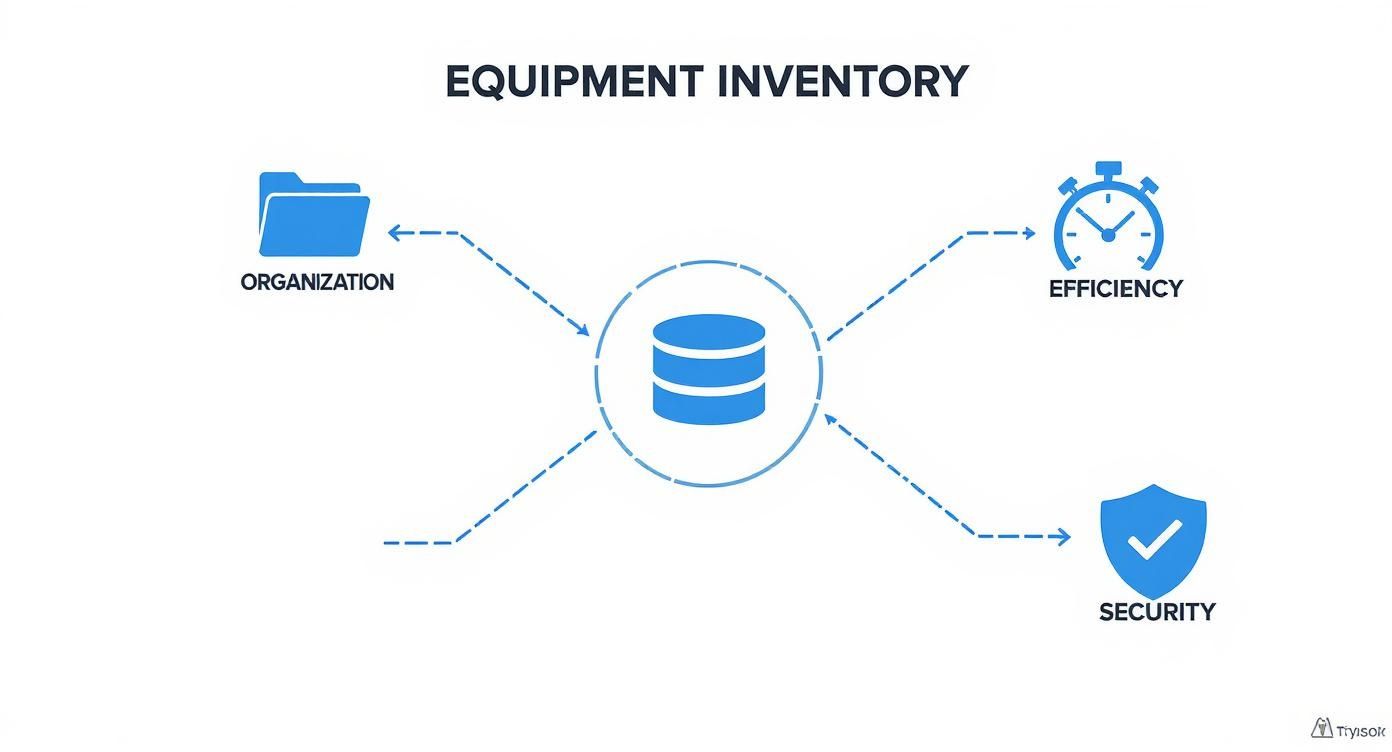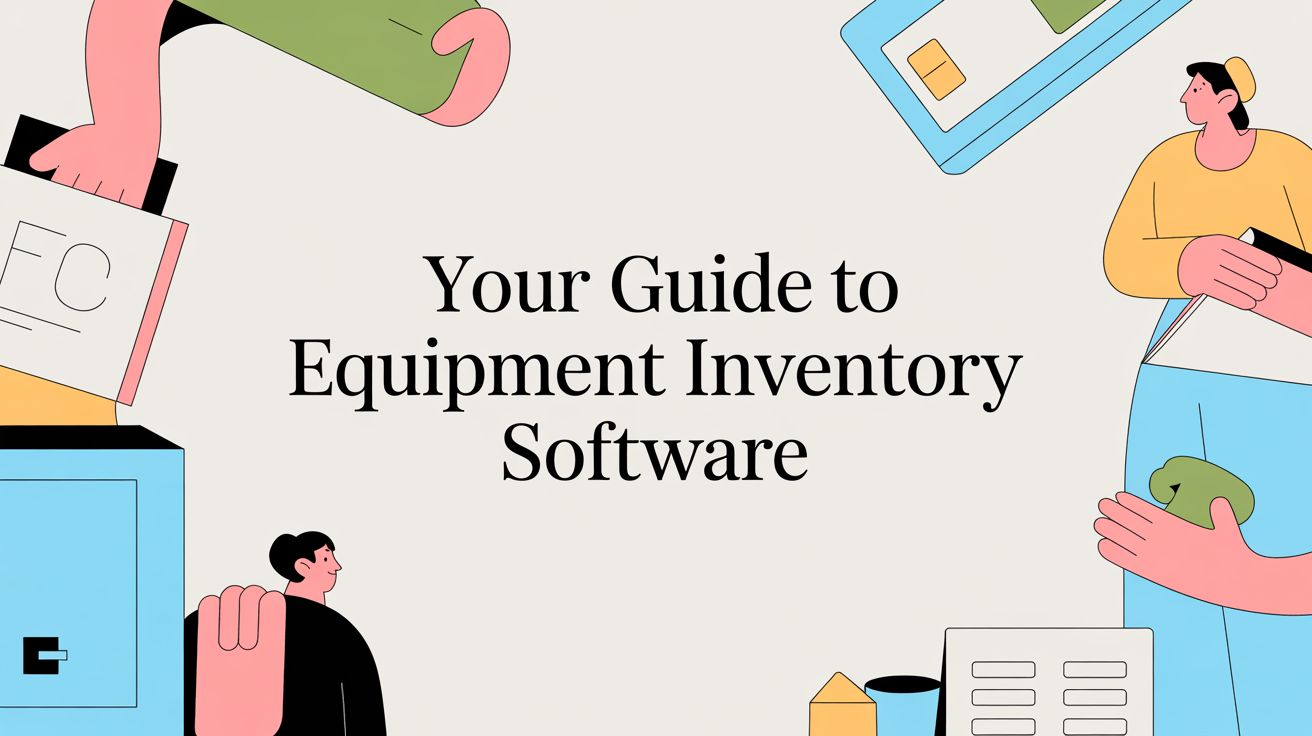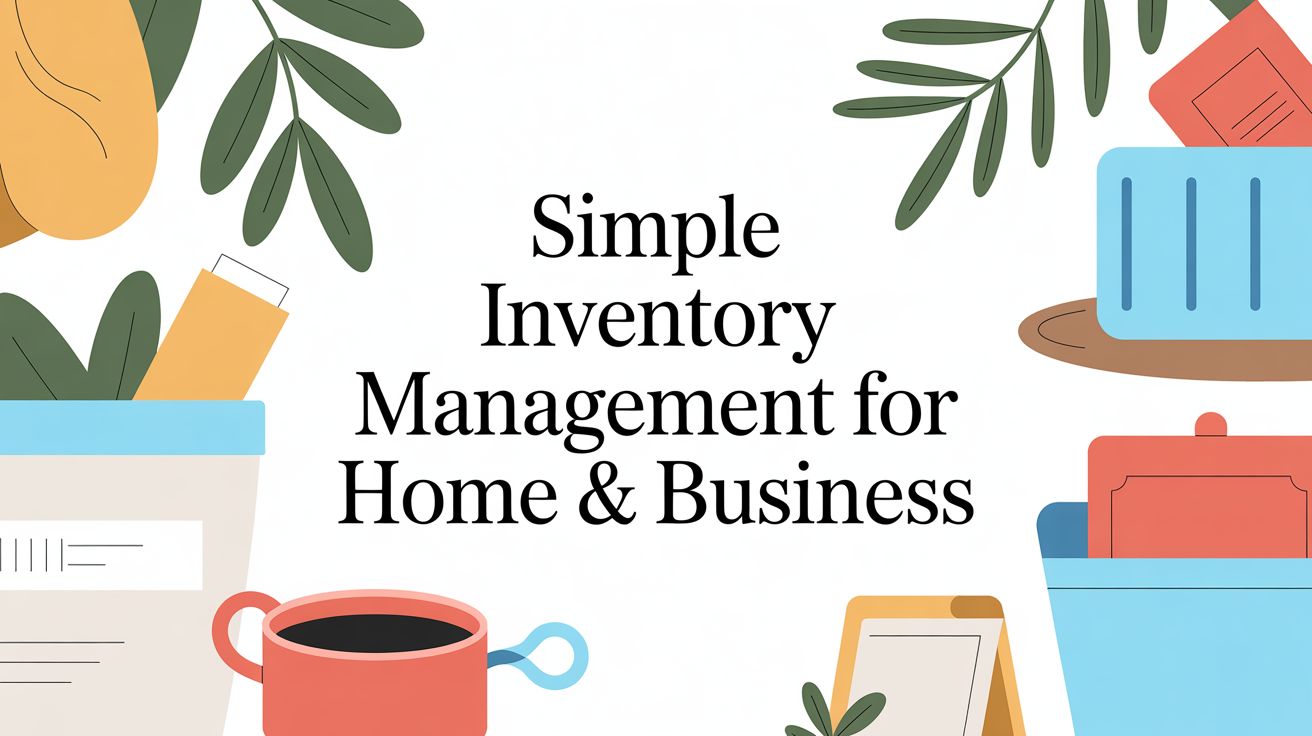At its core, equipment inventory software is a digital command center for all your physical assets. Think of it as a specialized tool that pulls everything you own, from your work computer and power tools to your living room furniture and family heirlooms, into a single, searchable database. It’s designed to turn the chaos of manual tracking into an organized, stress-free system.
Understanding Your Digital Asset Command Center
Let’s be honest. Your current method for tracking your stuff is probably a messy spreadsheet, a bulging folder of receipts, or maybe just a mental checklist that fails you when you need it most. That’s like having a library with no card catalog; you know the information is in there somewhere, but finding it is a frustrating, time-consuming mess.
Equipment inventory software is that digital card catalog, but on steroids.
Instead of just a line in a spreadsheet, the software lets you attach photos, receipts, warranty documents, serial numbers, and purchase dates to every single item. All of a sudden, every important detail about everything you value is in one secure, easily accessible place. This kind of organized knowledge is a game-changer for everything from financial planning to being prepared for an insurance claim.
From Manual Lists to Automated Systems
Making the jump from a manual list to dedicated software is more than just a convenience; it’s a fundamental shift in how we manage and protect our belongings. The global inventory management software market has exploded for a reason, showing a massive move toward digital asset tracking.
The market was valued at around USD 3.58 billion and is expected to hit USD 7.14 billion by 2033, growing at a steady clip of 8.4% each year. You can dig into more data on the industrial asset management software market from Verdantix to see the trend for yourself.
This growth isn't just about corporate buzz; it highlights the real-world value these systems deliver. We're moving beyond simple lists to something that offers genuine security, rich data, and true peace of mind.
Spreadsheet vs. Equipment Inventory Software
While a spreadsheet is definitely a step up from a paper notebook, it hits its limits fast. The difference becomes painfully clear when you need detailed information in a hurry, especially during a stressful event like filing an insurance claim after a fire or theft.
A detailed and verifiable inventory is one of the most important tools you can have when you need to file an insurance claim. Having everything documented beforehand can significantly speed up the claims process and ensure you receive fair compensation.
It’s easy to think a spreadsheet is "good enough," but let's put the two methods side-by-side to see where the cracks in the manual method really show.
| Feature | Spreadsheet (Manual Method) | Dedicated Software (Automated Method) |
|---|---|---|
| Data Entry | Fully manual; prone to typos and inconsistencies. | Often automated with barcode/QR scanning and photo recognition. |
| Document Storage | Cannot directly attach files; requires separate folder management. | Allows direct attachment of receipts, warranties, and manuals to each item. |
| Accessibility | Limited to the device where the file is stored unless manually synced. | Cloud-based; access your inventory from any device, anywhere, anytime. |
| Searchability | Basic text search; struggles with complex queries or visual searches. | Advanced search filters, keyword tagging, and sometimes image-based search. |
| Security | Vulnerable to data loss from device failure, theft, or accidental deletion. | Secure cloud storage with encryption and regular backups for data protection. |
| Reporting | Requires manual creation of reports for insurance or financial purposes. | Generates detailed, professional reports with just a few clicks. |
Ultimately, a spreadsheet can hold basic data, but equipment inventory software gives you a dynamic, secure, and infinitely more useful system for managing what you own. It's a small investment in organization that pays huge dividends in efficiency and security down the road.
Unpacking Key Software Features
A simple list of your belongings is one thing. True equipment inventory software is another beast entirely. The features are what transform a static spreadsheet into an interactive command center for your stuff, a dynamic tool that brings organization, efficiency, and security to your fingertips.
It all starts with the central dashboard. Think of it as the mission control for your home. In one glance, you get a bird's-eye view of everything you own, where it is, and what needs attention. No more digging through filing cabinets or squinting at an old spreadsheet.
This infographic breaks down how the core software functions work together to deliver on the big three promises of inventory management: organization, efficiency, and security.

As you can see, that central database isn't just a list; it's the foundation that unlocks powerful capabilities for getting a real handle on your physical assets.
Streamlining Data Entry and Access
Let's be honest: nobody wants to manually type in the details for hundreds of items. It’s a surefire recipe for boredom and typos. This is where modern inventory software really shines, turning a tedious chore into a quick and accurate process.
Key features that make life easier include:
- Barcode and QR Code Scanning: This feature turns your smartphone into a magic wand. Instead of fumbling with serial numbers, you just scan a code on your new TV or power tool, and the software instantly pulls in the key details.
- Cloud Synchronization: This is a total game-changer. It means your inventory is always live and up-to-date, whether you're on your laptop at home or using your phone in the garage. Add a new tool on your mobile app, and it’s there on your desktop before you even walk inside.
- Document Attachments: Forget that frantic search for a crumpled receipt or a lost user manual. With this, you can snap a photo of your warranty, receipt, or instructions and attach it directly to the item's profile. Everything you need is right where it belongs.
These tools don’t just save you a little time, they eliminate the grunt work and dramatically cut down on human error, which is a massive headache in any manual tracking system.
Customization and Powerful Search
Your collection of vintage cameras isn't the same as your collection of power tools, so why should you track them the same way? Good software gets this. It gives you the flexibility to track the details that actually matter to you, while making it ridiculously easy to find anything in seconds.
Effective inventory management is built on a simple principle: "what gets measured, gets managed." By tracking specifics like purchase price and warranty expiration, you empower yourself to make smarter decisions.
This is where you can really tailor the system to your life. You can see how this works in practice by exploring the Vorby features to see how these tools are designed specifically for home and personal inventories.
Consider these powerful options:
- Custom Fields: This lets you add your own data points. For a homeowner, that might mean "Room Location" or "Warranty Expiration Date." For a hobbyist, it could be "Condition" or "Appraisal Value." You decide what’s important.
- Advanced Search and Filtering: A truly powerful search bar is your best friend. It lets you instantly find what you're looking for by name, category, or even one of your custom tags. You can pull up "all electronics purchased last year" or "every item in the attic" with just a couple of clicks.
Where This Really Clicks: Real-World Uses for Homes and Businesses
The theory behind equipment inventory software is great, but its real power shines when you see how it solves messy, everyday problems. This isn't just about making tidy lists; it's about turning a jumble of information into something you can actually use to save time, money, and a whole lot of headaches. It's the bridge between knowing what you own and being able to act on that knowledge.

Whether you’re a homeowner trying to get ahead of life’s curveballs or a freelancer juggling expensive gear, the benefits are immediate. Let's dig into a few specific situations where a system like this proves its worth.
Essential Applications for Homeowners
For anyone who owns or rents a home, an organized inventory is your best defense against chaos. It’s a calm, structured record of your most important possessions, ready and waiting for the moment you need it most.
Picture this: a pipe bursts in the middle of the night, flooding your home office. Instead of panicking and trying to remember every single piece of damaged electronics from a waterlogged memory, you just open an app on your phone.
In a few taps, you pull up a complete report for your insurance adjuster, packed with photos, serial numbers, purchase dates, and even digital receipts. That level of detail can slash the time it takes to process your claim and helps ensure you get what you're owed.
This kind of preparedness is a game-changer in other parts of home life, too:
- Estate Planning: A clear, documented inventory makes allocating assets so much simpler. It gives executors and family members a complete list, preventing the confusion and arguments that can happen during stressful times.
- Managing Collections: Do you collect vintage guitars, rare books, or fine art? The software helps you track each piece's value, condition, and history. You can attach appraisal documents and photos, building a professional-grade catalog of your passion.
- Warranty and Repair Tracking: For every big-ticket appliance and gadget, you can log warranty expiration dates and service records. This simple step helps you stay on top of maintenance and saves you from paying for repairs that should have been covered.
Indispensable Tools for Small Businesses and Freelancers
If you run a small business, every tool, laptop, and piece of equipment is an investment. Keeping track of it all isn't just good housekeeping, it's critical for your financial health and daily operations. It’s no surprise that North America holds a dominant market share of over 40% in the equipment inventory software space; businesses here were quick to see the value in having a real-time handle on their assets.
Think about a freelance photographer who rents out her extra camera gear. The software becomes the command center for her entire side hustle.
When a client wants to book a lens, she can instantly check its availability, schedule the rental, and document its condition before it ever leaves the studio. When it comes back, a quick check against the record makes the return process seamless and professional. Exploring different use cases for inventory software can spark even more ideas for streamlining your work.
This level of control is crucial for all sorts of business activities:
- Tracking Company Assets: Know exactly where every company laptop, tool, and phone is. Assigning items to employees creates accountability, reduces the risk of things "walking away," and helps you plan for future upgrades.
- Managing Rental Equipment: For any business that rents out items, from party tents to construction equipment, the software is essential. It tracks availability, maintenance schedules, and rental history, helping you squeeze every last drop of earning potential out of your inventory.
- Streamlining Audits and Financials: An accurate inventory gives your accountant the precise data needed for financial audits, depreciation calculations, and tax reporting. It’s a clean, verifiable record of all your business's physical assets.
How to Choose the Right Inventory Tool
Choosing the right equipment inventory software feels like a big decision, but it really doesn't have to be. The best tool isn't the one with a million features; it's the one that actually fits your life and solves the specific organizational headaches you're dealing with. Finding that perfect match starts by asking yourself a few honest questions.
First, think about the sheer scale of your inventory. Are you just trying to catalog a couple dozen high-value electronics, or are you documenting hundreds of items for a small business or an extensive collection? Your answer will point you toward a solution that can handle your volume without feeling like overkill or, worse, coming up short.
This kind of self-assessment is the bedrock of making a smart choice. Once you have a clear picture of what you need, you can start looking at different options with a ton of confidence.
A Practical Checklist for Your Decision
To start narrowing things down, let's walk through a simple checklist. This isn't about getting bogged down in technical specs; it’s about how the software will actually work for you day-to-day. A tool that looks amazing on paper is totally useless if it’s a pain to use.
Before you commit to anything, consider these key factors:
- Ease of Use: Is the interface clean and intuitive? A user-friendly design is non-negotiable if you want to stick with the system. Look for a tool that makes adding items and finding information feel completely effortless.
- Mobile Accessibility: Do you need to manage your stuff on the go? A dedicated mobile app with full functionality, like barcode scanning and quick photo uploads, is a must-have for tracking items as you buy them or move them around the house.
- Customization Options: Can you add custom fields that actually matter to you? A collector, for example, might need an "Appraised Value" field, while a homeowner would get more use out of tracking "Warranty Expiration" dates.
- Physical Tagging Support: Does the software work with modern tracking methods? The ability to generate and scan QR codes or use NFC tags can make finding a specific item in a stack of storage boxes incredibly fast. If you're new to this, you can learn more about what asset tags are and how they work in our detailed guide.
Answering these questions will help you build a clear profile of your ideal software, cutting through the noise and letting you focus on what truly matters.
Understanding Pricing Models
Navigating software pricing can feel confusing, but most inventory tools fall into a couple of common buckets. Getting a handle on these models helps you find a solution that fits your budget without any surprises. You'll generally run into two main structures.
The first is the subscription model, which is by far the most common. You pay a recurring fee, either monthly or annually, for access to the software and all its ongoing updates. This model is popular for a reason, since it usually includes cloud storage, customer support, and a steady stream of improvements without any extra charges.
Subscription-based software ensures you are always on the latest version, with access to new features and security patches as soon as they are released. This model often provides a lower upfront cost, making it accessible for personal and small business use.
The second option is a one-time purchase. With this model, you pay a single, larger fee to own a license for the current version of the software forever. While this can be more cost-effective over many years, it often means you'll have to pay again for major upgrades or new versions down the line.
The Non-Negotiable Factor: Security
Finally, and this is the big one, we need to talk about security. You're entrusting a system with a detailed list of your valuable possessions. Protecting that information has to be the absolute top priority for any software provider you consider.
Do not compromise on this. Look for clear, upfront statements about a company's security practices. A reputable provider will be transparent about how they keep your data safe.
Here’s what to look for specifically:
- Data Encryption: The software should use strong encryption to protect your data both when it's stored on their servers (at rest) and when it's being sent over the internet (in transit).
- Privacy Policy: Take a minute to actually read the privacy policy. Make sure the company won't sell or share your personal data with third parties.
- Secure Backups: A good provider performs regular, secure backups of all your inventory data to prevent loss in case something goes wrong on their end.
Choosing an equipment inventory software is an investment in your own peace of mind. By prioritizing a user-friendly design, flexible pricing, and ironclad security, you can find a tool that not only organizes your life but protects it, too.
A Simple Checklist for Getting Started
You’ve done the research and picked your equipment inventory software. Now for the fun part: turning that tool into a system that actually organizes your life. To make sure it all goes smoothly, here's a simple checklist to help you build a valuable, sustainable inventory without getting overwhelmed.

The real key here is to avoid the temptation to catalog everything you own in a single weekend. That's a surefire recipe for burnout. Instead, we'll break it down into small, manageable steps that build momentum and turn this into a lasting habit.
1. Start Small With a Single Category
The single biggest mistake people make is aiming too big, too soon. Don't try to inventory your entire house at once. Instead, pick one self-contained category to get a feel for the process and score an easy win.
A great place to begin is your home office or entertainment center. These areas are usually packed with high-value electronics that have clear model numbers and purchase details, making them the perfect guinea pigs. This focused approach lets you learn the software's workflow on a small, controlled set of items.
Other great starting categories include:
- Kitchen Appliances: Catalog your microwave, coffee maker, and stand mixer.
- Power Tools: Document the tools in your garage or workshop.
- Valuable Collections: Focus on your most prized collectibles, like cameras or watches.
2. Gather Your Essential Information
Before you start adding anything, take a few minutes to gather the necessary documents. Having everything on hand makes the data entry process way faster and more accurate. Think of it like prepping your ingredients before you start cooking; a little work upfront saves a ton of hassle later.
For each item in the category you chose, try to find:
- Receipts: Digital or physical copies are crucial for proving ownership and value.
- Serial and Model Numbers: These are the unique IDs you'll need for any insurance claim or warranty service.
- Warranty Documents: Note the expiration date so you never miss a chance for a free repair.
- User Manuals: Attaching a digital copy means you'll never lose it again.
Once you have this info ready, you can move on to the most important part of building an inventory that’s actually useful.
3. Build a Rich and Visual Inventory
Now it's time to put your equipment inventory software to work. As you add each item, make a point to use its best features from day one. Don't just create a basic list; build a rich, detailed record that provides real value.
A truly useful inventory is more than just a list of names. It’s a visual and informational database that tells the complete story of each asset you own, making it an indispensable tool for insurance, maintenance, and organization.
Make a habit of including these details for every single entry:
- Take Multiple Photos: A picture is worth a thousand words, especially to an insurance adjuster. Snap clear photos from different angles, including a close-up of the serial number and any existing scratches or dings. This visual evidence is priceless.
- Attach All Documents: Scan or take a picture of your receipts, warranties, and manuals, and upload the digital files directly to the item's entry in the software.
- Use Descriptive Names and Notes: Instead of just "Laptop," write "Dell XPS 15 (2023) - Home Office." In the notes, add details like "Purchased from Best Buy" or "Upgraded RAM in January 2024."
- Assign Locations: Be specific. Don't just put an item in a room; note that it's in the "top drawer of the oak desk" or the "blue storage bin in the garage." This is the kind of precision that makes your inventory genuinely useful when you need to find something fast.
Follow these steps, and you won’t just have a list, you’ll have a detailed, organized, and genuinely helpful asset database that delivers lasting peace of mind.
Got Questions About Equipment Inventory? Let's Clear Things Up.
Even after seeing all the benefits, it's totally normal to have a few questions before you dive into a new way of organizing your life. Let's be real, adopting any new tool, especially one that keeps a detailed record of your valuable stuff, deserves some serious thought. This section is all about tackling the most common concerns and uncertainties head-on.
We'll give you clear, straightforward answers to help you feel confident about moving forward. The goal is to iron out any hesitations and show you just how practical and secure these systems can be for anyone looking to bring a little order to their physical world.
"Is My Data Actually Safe in the Cloud?"
This is always the first question, and it's a good one. Handing over a detailed list of your possessions to an online service can feel like a big leap of faith. But here's the thing: reputable software providers treat your security as their absolute top priority. In fact, your data is often far safer on their specialized servers than it would be on your personal laptop or in a spreadsheet on your home computer.
Think about it. Your personal devices face all sorts of risks. They can be lost, stolen, fried in a power surge, or hit with malware. A single hard drive failure could wipe out your entire inventory in a blink.
Reputable cloud-based companies use multiple layers of security to protect your information 24/7. This usually includes:
- Advanced Data Encryption: Your inventory data is scrambled with powerful encryption, both when it's stored on their servers (at rest) and when it's traveling between your device and their servers (in transit). This makes it completely unreadable to anyone without the right key.
- Secure Server Infrastructure: Their servers live in highly secure data centers with physical security, backup power, and constant monitoring to prevent unauthorized access and keep the service running smoothly.
- Regular Security Audits: The best providers hire outside security experts to try and break into their own systems. This helps them find and fix vulnerabilities, ensuring their defenses are always ready for the latest threats.
The bottom line? Choose a provider that's transparent about its security practices. A trustworthy company will have a clear privacy policy and will be open about the steps they take to protect your data, giving you genuine peace of mind.
"Is This Software Really Practical for Just a Home Inventory?"
Absolutely. The term "equipment inventory" might conjure up images of a big company with a warehouse full of tools, but these systems are incredibly practical and valuable for personal and household use. The core idea, which is knowing what you have, where it is, and what it's worth, applies just as much to a family home as it does to a construction business.
For homeowners and renters, the benefits are immediate. Creating a detailed home inventory is one of the single best things you can do to prepare for something unexpected, like a fire or theft. It makes insurance claims a thousand times easier, helps with estate planning, and even makes moving day less of a nightmare.
Many modern tools, like Vorby, are designed specifically with homeowners in mind. They offer features built for everyday life, helping you manage everything from your electronics and appliances to your valuable collections and sentimental items with total ease.
"How Much Time Will the Initial Setup Really Take?"
Okay, the idea of cataloging every important thing you own can sound like a massive project. The initial time investment is a valid concern. The secret is to reframe the task completely. You don't have to document your entire house in one weekend. The most successful approach is to start small and build momentum.
Try this: dedicate just 15 to 30 minutes to the task a few times a week. Start with one small, contained area, like your home office desk or that one shelf of power tools in the garage. Add just a handful of items in each session. This breaks the project down into manageable chunks and stops you from feeling overwhelmed.
Once you get into a rhythm, you'll find the process gets way faster. Features like barcode scanning and photo uploads can dramatically speed things up, turning what seems like a huge project into a simple, satisfying habit. And remember, a partially complete inventory is infinitely better than no inventory at all.
"What's the Difference Between Asset Tracking and Inventory Management?"
You'll hear these two terms thrown around a lot, and while they sound similar, they refer to slightly different things. Understanding the distinction helps clarify exactly what equipment inventory software is built for.
Inventory management usually focuses on tracking things that are meant to be sold or used up. Think of a retail store's stock or a cafe's coffee beans. The main goal is to manage the flow of goods in and out to meet demand and control costs.
On the other hand, asset tracking is all about managing the items a household or business owns and uses to function, the things you don't plan on selling. These are your fixed assets.
Here’s a simple way to look at it:
| Aspect | Inventory Management | Asset Tracking |
|---|---|---|
| What It Tracks | Consumable or for-sale goods (e.g., retail products, parts). | Owned items used for operations (e.g., computers, tools, furniture). |
| The Main Goal | Manage stock levels for sales and production. | Monitor the location, condition, and lifecycle of valuable assets. |
| The Focus | The turnover and flow of goods. | The maintenance, use, and security of the stuff you own. |
Equipment inventory software is a specialized form of asset tracking. It's designed to create a detailed, long-term record of the valuable things you own and want to keep track of for years to come.
Ready to transform your chaotic home into an organized sanctuary? With Vorby, you can finally get a handle on everything you own. Our powerful features make it easy to catalog your belongings, find anything in seconds, and manage your household with total confidence. Start your free trial today and discover a smarter way to stay organized.



